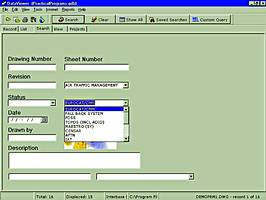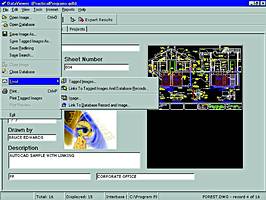CAD orientated data management system
February 2002
As CAD-based design offices grow larger and accumulate ever-larger volumes of work records, the need for a data management system becomes apparent.
A data management system comprises a database system that stores information about all the documents and drawings, their storage locations, revision history, approvals, issues and inter-relationships. It makes it easy to find documents by various search criteria, and to also find all related documents. It may also serve to manage the archiving or back-up of data, and the gathering of data for issuing or transmittal.
Data management systems used to be either very powerful, costly systems that could handle immense volumes of data and involved a daunting implementation process, or else were suited to small offices but had definite upper limits on their ability to handle the data of a growing business. As well as the data volume handling capability, data management systems are also expected to provide access control to ensure that only those who are authorised can view, print or alter data.

Record tab with e-mail links menu highlighted
Access security
There are two main methods of implementing access security. One relies on the file access control mechanisms of the computer network operating system. The other imposes an additional layer of protection by hiding all the data it controls in a secret place, called a 'vault'. The files stored in the vault are encrypted or otherwise concealed, and can only be accessed via the data management system.
A vault-based system offers the ultimate in access security, but at the cost of considerable complexity and generates concerns about the continued accessibility of the data if the management software malfunctions.

Search tab with hierarchical pull-down menu
Straightforward task
Practical Programs of Australia has developed DataViewer, a CAD-oriented data management system suitable both for quite small networks and data volumes, as well as for very large systems. Its initial implementation is quite a straightforward task that does not take long or cause major disruption to the office while in progress, as is the case with vault-based systems. It runs on Windows NT or 2000 networks and uses the access controls provided by the network system.
Database systems
The main factor affecting a system's ability to handle very large data volumes is the type of database system it uses for holding the records. There are basically two types of database systems.
One uses an application program that is run on each user's computer whenever that user needs to access the database. The actual database files are stored in one location, such as on the network file server with shared access. These systems need to copy sections of the database into a local work area whenever users have to alter or extract data. If there are a large number of simultaneous users and very large database files, the network traffic soon becomes so great that the system becomes sluggish.
The other type is called a client-server system. Here the database server program runs only on the network server and runs continuously. Users run the database 'client' application, which sends queries to the central data manager and receives copies of just the selections of data required, or sends update requests to the server. Common systems of this type are Oracle, Microsoft SQL/Server, Interbase, Sybase.
Usually, the smaller data management systems have a database system built-in of the shared-data type. The large systems are usually designed to work with one particular client-server database system.
DataViewer is unusual in being able to work with a variety of database systems of both types. This makes it adaptable to a wide range of office sizes. It also means that it can make use of an office's existing database system, such as that used for inventory control or ordering. The database systems it supports are Microsoft Access, Paradox, Interbase, Microsoft SQL/Server and Oracle. Interbase is a client-server system produced by the makers of the programming system used for DataViewer, Delphi, and will often prove to be the most cost-effective option when an office does not already have a database system.
Typical Windows application
Data management systems, by their nature, usually need to be customised to each office situation. With DataViewer, the system can be set up much like a typical Windows application, and configured to the office situation interactively via a 'wizard' that asks questions in sequence. The system provides default on-screen and printer form layouts, which are often adequate as delivered, but can at any time be customised. Hence the system can be implemented quickly and easily and brought into effective operation, and then its configuration and the design of its forms and screens can be refined in the light of experience as work proceeds. It also avoids the daunting implementation hurdle that had obstructed the adoption of some data management systems.
DataViewer can be configured to perform repetitive tasks automatically. It can be used to circulate information by sending people links to the central data rather than sending copies. This avoids filling up disks with multiple copies of files and also avoids the risk of having superseded information held locally.
DataViewer does not require data to be moved to its own special storage areas, and allows one to organise data storage as desired, possibly split over several servers. It provides several levels of access permission, applied to individual documents or groups of files. In addition, files can be protected with 128-bit encryption without having to be moved or renamed.
Projects can be set up and configured to display data files organised in a hierarchic system appropriate to that project, even though their actual storage locations are organised quite differently. This is called a Project Tree. A web client module allows access to the system with proper control, from anywhere on the intranet or Internet. An unusual facility is digital signatures
Further, DataViewer includes a system for collecting selected files and their related files and bundling them together in a zip file together with transmittal details. It can also organise the emailing of such transmittals. The standardised zip process can considerably compress many types of data, including line-based CAD data, although raster image data is harder to compress if scanned to a compressed format.
DataViewer also includes adata compression system for colour raster images that has an unusual capability called 'colour streaming' when the compressed data is used on a network or web server. In those situations, it serves up just enough resolution and data extent to satisfy the display needs at the time, interactively. For example if one has to access a large map and the entire extents of the map fill the viewing area, it sends no more resolution than can be usefully displayed - enormously less data volume than the full extent, full resolution of the data on the server.
Kinetic Distribution
(031) 266 7027
Others who read this also read these articles
EDM - who needs it?
An EDMS is basically a computer database system designed for keeping track of documents, changes to them, related documents, and possibly to control the access to documents and assist or even enforce established procedures for workflow or QA[ December 2005 ]
Spatial document management
ProjectWise is the most popular technical document and AEC content management tool in SA and adding a spatial component opens up a whole new dimension[ August 2004 ]
What is up, docs?
DvTDM, the Total Document Manager developed by Practical Programs, and is available from Kinetic Distribution, can actually be configured to force documents to be stored within the system[ August 2004 ]
The CAD File is the business
CAD files form the technical foundation from which industrial businesses and plants are run[ August 2003 ]
The high cost of information erosion
Intergraph Process, Power & Offshore has developed integrated solutions and products to assure data accuracy and consistency, and enable the efficient creation, management and use of plant engineering information throughout the plant lifecycle[ June 2003 ]
Powerful document management solution
DataViewer X is an advanced Document and Drawing Management solution that can interface with leading CAD products to produce advanced technical and product document solutions[ February 2003 ]
Digital signatures resolve electronic catch-22
The much-touted 'paperless' work environment has finally become a reality[ December 2002 ]
MicroStation V8 is e-ready for digital signatures
Recent acknowledgment of digital IDs, certificates, and signatures offers new opportunities to streamline workflows and strengthen the protection of one's digital intellectual property[ October 2002 ]
Others who read this also read these news items
A solution to CAD data management problems
[ October 2005 ]
Engineer your drawing management
[ August 2005 ]
The paperless age
[ June 2005 ]
Effectively handle document processes
[ April 2004 ]
Flexible solution for digitising drawings
[ February 2004 ]
Dataviewer X gets new name and enhancements
[ February 2004 ]
World's largest export coal terminal discovers SAP DMS
[ February 2004 ]
New software to index and archive scanned drawings
[ February 2004 ]
Others who read this also read these regulars
Search Site
Subscribe
Previous Issues
Other Technews Publications
Other Technews Buyers Guides
 |  | Copyright c1995-2009 Technews Publishing (Pty) Ltd.. All rights reserved. |